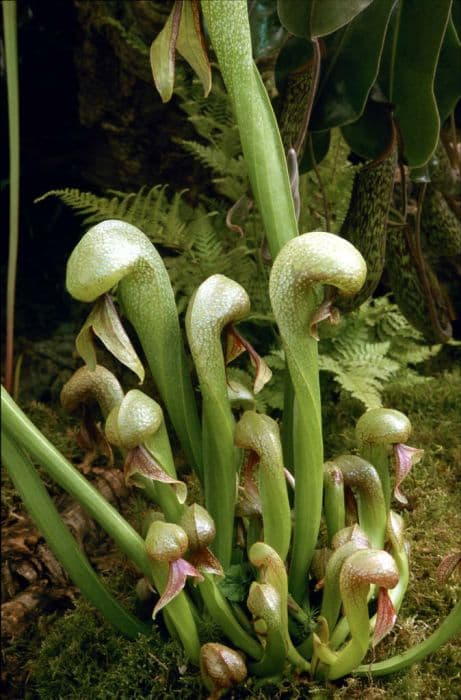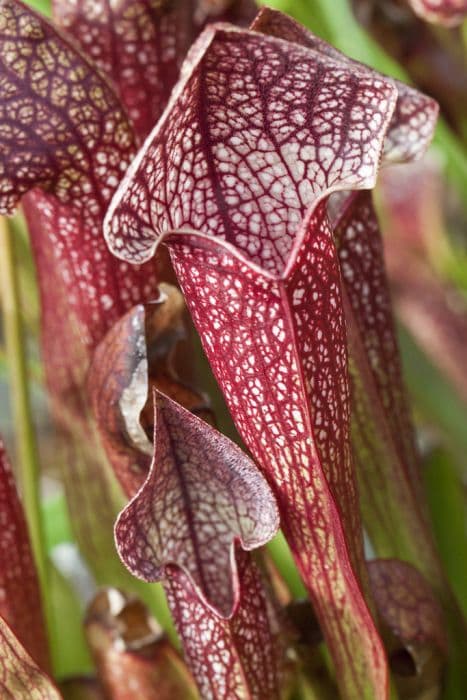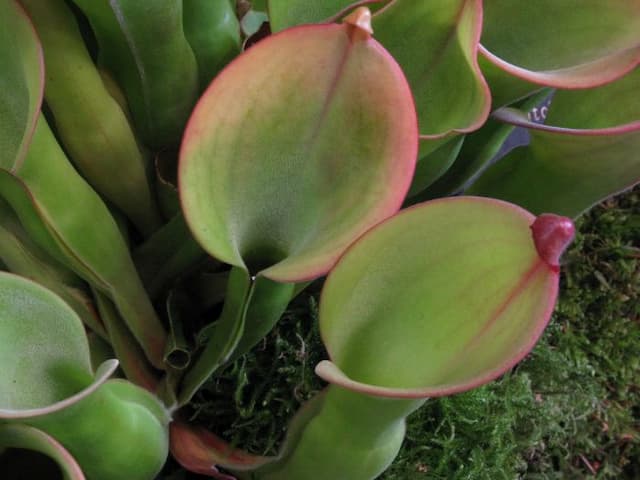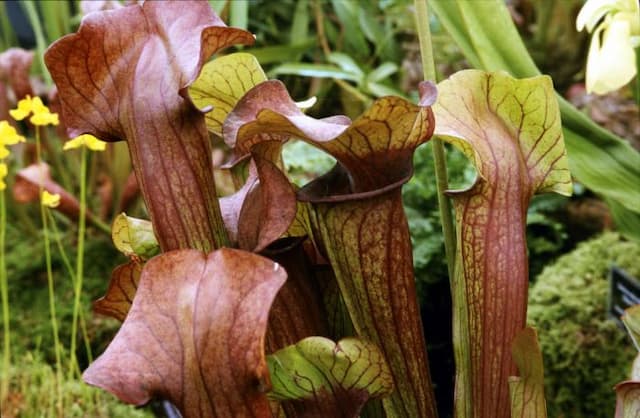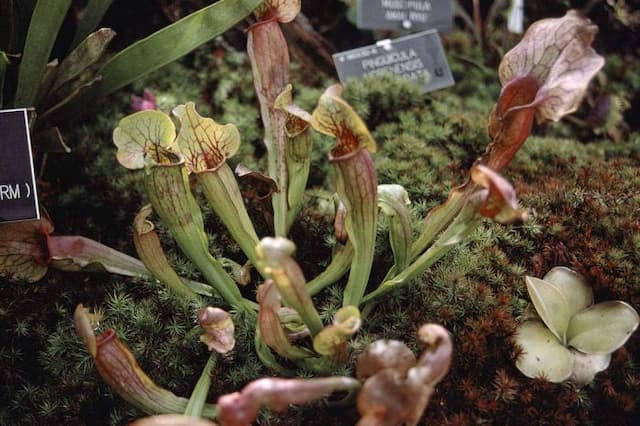Pitcher plant Sarracenia × excellens 'Judy'

ABOUT
The Sarracenia × excellens 'Judy', also known as the pitcher plant, showcases a striking appearance characterized by its unique pitcher-like leaves. These leaves are specialized structures that form tubular shapes, with a distinctive curved hood over the opening at the top, which helps to prevent excess rain from diluting the digestive fluids within. The pitchers are often vibrantly colored with combinations of greens, reds, and purples, which can create intricate vein-like patterns and speckled markings that serve to attract insects. At the base of the pitchers, the plant starts with a rosette of leaves spreading outward. The pitchers themselves can have a variety of surface textures; some are smooth, while others can be covered with fine hairs. Inside, the walls of the pitchers are slippery and contain downward-pointing hairs, making it difficult for trapped prey to escape. The pitcher plant blooms with flowers that hang upside down from tall, sturdy stalks. These flowers can be quite large and are usually a combination of colors that may include yellows, reds, and greens. Each flower has a unique umbrella-like structure that adds to the plant's exotic look. The pitchers of Sarracenia × excellens 'Judy' are not only visually interesting but also serve a vital function in the plant's survival, acting as pitfall traps for insects, which are lured in by nectar and the plant's coloration, before being digested by the plant's enzymes.
About this plant
 Names
NamesFamily
Sarraceniaceae
Synonyms
Hybrid Pitcher Plant, Pitcher Plant
Common names
Sarracenia × excellens 'Judy'.
 Toxicity
ToxicityTo humans
Pitcher plants, including Sarracenia × excellens 'Judy', are not known to be toxic to humans. These carnivorous plants primarily trap and digest insects, and there are no common reports of poisoning or adverse effects from ingesting parts of the plant. Nonetheless, it is generally not recommended to eat any plant parts unless you are certain of their safety and edibility.
To pets
Pitcher plants like Sarracenia × excellens 'Judy' are not typically toxic to pets. There is no widespread evidence to suggest that pets ingesting parts of this plant would experience poisoning. However, it is always a good practice to prevent pets from eating plants, as individual animals might have different sensitivities, and non-toxic plants can still cause gastrointestinal upset or other health issues if ingested in large quantities.
 Characteristics
CharacteristicsLife cycle
Perennials
Foliage type
Deciduous
Color of leaves
Green
Flower color
Varies
Height
1-3 feet (0.3-0.9 meters)
Spread
1-2 feet (0.3-0.6 meters)
Plant type
Herb
Hardiness zones
6
Native area
Southeastern United States
Benefits
 General Benefits
General Benefits- Attracts Pollinators: Sarracenia × excellens 'Judy', also known as pitcher plant, can attract beneficial insects like bees which are essential for the pollination of many plants.
- Educational Interest: The plant's unique carnivorous nature makes it an intriguing subject for study and education about diverse plant adaptations.
- Aesthetic Appeal: Pitcher plants have exotic-looking foliage and flowers that can add an interesting visual element to gardens and indoor displays.
- Pest Control: By attracting and trapping insects, the pitcher plant may help to naturally reduce the populations of certain pests.
- Conservation: Growing pitcher plants can contribute to the conservation of these interesting species, as their natural habitats are under threat.
- Low Maintenance: As a carnivorous plant, it requires minimal fertilization and, once established, can be relatively easy to care for.
- Hobby Interest: Cultivating pitcher plants can be a rewarding hobby for enthusiasts who are interested in carnivorous plant care and propagation.
 Medical Properties
Medical PropertiesThis plant is not used for medical purposes.
 Air-purifying Qualities
Air-purifying QualitiesThis plant is not specifically known for air purifying qualities.
 Other Uses
Other Uses- Photographic subjects: Sarracenia 'Judy' can provide an interesting and unique subject matter for photographers, especially those specializing in macro or nature photography.
- Science education: These pitcher plants can be used in classrooms to demonstrate carnivorous plant biology and the concept of ecological niches.
- Art inspiration: Artists may draw inspiration from the unique form and colors of Sarracenia 'Judy' for their artworks, such as paintings or sculptures.
- Biological control: The plant can help control insect populations in gardens naturally, without the need for chemical pesticides.
- Conservation ambassador: Sarracenia 'Judy' can be displayed in botanical gardens or conservation exhibits, raising awareness about the preservation of carnivorous plants and their habitats.
- Culinary presentation: Although not edible, they could be used as a dramatic garnish for adventurous and decorative plating in culinary art.
- Thematic gardens: They can be featured in gothic or fantasy-themed gardens due to their exotic and mysterious appearance.
- Floral arrangements: While uncommon, the pitchers may be used in avant-garde floral designs to add an unusual and striking element.
- Seasonal decor: In regions where Halloween is celebrated, Sarracenia 'Judy' can contribute to spooky-themed decorations because of its carnivorous nature.
- Ecosystem education: They can serve as a practical example in ecological education about the interdependence of species within habitats.
Interesting Facts
 Feng Shui
Feng ShuiThe Pitcher Plant is not used in Feng Shui practice.
 Zodiac Sign Compitability
Zodiac Sign CompitabilityThe Pitcher Plant is not used in astrology practice.
 Plant Symbolism
Plant Symbolism- Uniqueness: The Sarracenia × excellens 'Judy', popularly known as the pitcher plant, is a hybrid with distinctive features that symbolize the uniqueness of an individual's character and personality.
- Attraction: Pitcher plants are known for their intricate mechanisms to attract insects, representing the power of attraction and the importance of being mindful of what we draw into our lives.
- Adaptation: As a plant that has adapted to thrive in poor soil by digesting insects, the pitcher plant symbolizes adaptability and making the most out of what we are given.
- Cunning: The pitcher plant's method of trapping prey may be seen as cunning, reflecting the idea of strategic planning and the intelligence behind natural design.
 Water
WaterThe Sarracenia × excellens 'Judy', commonly known as the Pitcher Plant, should be kept moist but not waterlogged. Water it by using the tray method, where you fill the tray with about one to two inches of distilled water or rainwater and let the plant absorb the water from the bottom. This should be done roughly once every two to three days during the growing season, decreasing to about once a week during the winter dormancy period. Always use non-tap water as Pitcher Plants are sensitive to minerals in tap water. It's hard to set a fixed amount of water due to varying conditions, but ensure the water level in the tray doesn't go dry for extended periods.
 Light
LightPitcher Plant thrives in full sunlight for at least six to eight hours a day. The best spot for it is outdoors in a sunny location or a very bright window sill if grown indoors. Avoid direct afternoon sunlight in extremely hot climates to prevent leaf burn.
 Temperature
TemperaturePitcher Plant is comfortable in temperatures ranging from 70 to 90 degrees Fahrenheit during the growing period and can survive winter temperatures down to 32 degrees Fahrenheit. The ideal temperature range for active growth is between 70 to 85 degrees Fahrenheit, with a dormancy period in winter that can tolerate brief exposures to freezing temperatures as long as the root zone is protected.
 Pruning
PruningPrune the Pitcher Plant by removing any dead or damaged foliage to encourage new growth and maintain plant health. This is best done in the early spring before the growing season starts. Pruning can be done annually or as needed when you notice spent pitchers or leaves.
 Cleaning
CleaningAs needed
 Soil
SoilThe Sarracenia, or Pitcher Plant, thrives in a soil mix that is acidic, with a pH of 4.0 to 5.5. A common recipe includes a mixture of 50% sphagnum peat moss and 50% perlite or sand. This mixture ensures proper drainage and mimics the plant's natural bog habitat, which is essential for its health.
 Repotting
RepottingPitcher Plants, including Sarracenia × excellens 'Judy', typically need repotting every 2 to 3 years. It's best to repot in the spring before the growing season begins. This allows the plant to establish itself in the new substrate and continue its growth cycle without interruption.
 Humidity & Misting
Humidity & MistingPitcher Plants like Sarracenia × excellens 'Judy' prefer high humidity levels, ideally between 50% and 80%. These conditions simulate the humid environment of their native bog habitats and are crucial for maintaining their health and encouraging proper pitcher development.
 Suitable locations
Suitable locationsIndoor
Provide bright light, keep soil moist, and maintain high humidity.
Outdoor
Full sun, protect from frost, keep the medium wet.
Hardiness zone
5-9 USDA
 Life cycle
Life cycleThe Sarracenia × excellens 'Judy', commonly known as a Pitcher Plant, begins its life cycle when seeds germinate after experiencing a cold stratification period that simulates winter. The germinated seeds develop into small rosettes, producing juvenile pitchers that are less elaborate than those of mature plants. As the plant ages, it enters a phase of vegetative growth, forming a larger rosette of mature pitchers, which are specialized leaves adapted to attract, capture, and digest insects. Throughout the growing season, the plant may produce non-carnivorous leaves called phyllodia, which contribute to photosynthesis and general growth. In response to longer daylight hours and warmer temperatures, it blooms in late spring or early summer, with flowers held aloft on tall scapes, which are pollinated by insects. After pollination and seed set, the plant may enter a period of dormancy during the cold months, usually reducing its above-ground presence, to re-emerge the following spring.
 Propogation
PropogationPropogation time
Spring-Early Summer
The Sarracenia × excellens 'Judy', commonly known as a hybrid pitcher plant, can be propagated most effectively through division, which is typically done in late winter to early spring before new growth begins. To propagate by division, carefully remove the plant from its pot and gently separate the rhizomes, ensuring that each division has at least one growth point or pitcher. It's important to use a sharp, sterilized blade to minimize damage and reduce the risk of infection. The divisions can then be potted individually in a well-draining, sphagnum moss-based medium. Keep the new plants moist and provide them with bright, indirect light to encourage root development and growth.
